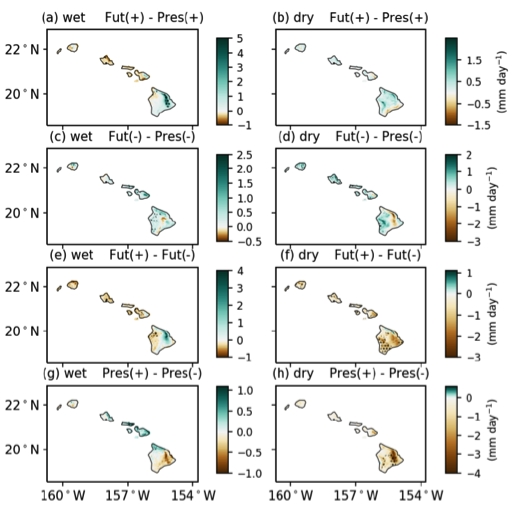
SPONSOR:
USGS, Pacific Islands Climate Adaptation Science Center
PROJECT PERIOD:
01/01/18 – 03/07/20
ABSTRACT:
Near-term climate change scenarios are increasingly important for strategic management, planning and decision-making processes. Regional climate change research projects have, until recently, focused almost exclusively on the long-term aspects of climate change by targeting the mid- and late-21st-century scenarios. However, stakeholders dealing with climate change related decision processes often require additional information on the developments in the coming two or three decades. The goal of this research project was to improve the scientific understanding of the range of near-term climate change trajectories and to develop near-term climate scenarios for the main Hawaiian Islands. Estimating human-induced (anthropogenic) climate change over the next 10–30 years is technically not different from the modeling of long-term changes. The main distinction is that the changes in regional climate in the next decades are relatively small compared with those expected by late in the century. On these shorter time scales, natural climate variability is expected to be at least as important as anthropogenic change. This can make the climate change signal difficult to detect. Scientists have developed modeling and statistical methods to improve the detection of such signals. In this project we generated a set of regional climate simulations for the period 2026–2035 and compared them with simulations for 1996–2005. The information was statistically analyzed and summarized for key climate variables including seasonal average temperature and precipitation values and extreme temperatures and precipitation. We found that temperatures will continue to increase in the coming decades, while precipitation changes in Hawai‘i will remain relatively weak. To plan for specific regional impacts or risks, it is important to keep in mind that natural variability can either diminish or amplify anthropogenic changes and because the timing of natural variability is difficult to predict, it contributes to uncertainty in climate projections over the near term.
PRINCIPAL INVESTIGATOR
THOMAS GIAMBELLUCADirector, WRRC; Professor, Department of Geography and Environment
Phone: (808) 956-7848
E-mail: thomas@hawaii.edu
